Horse Ear Bonnets, also known as ear hoods or fly masks, are a common sight in the equestrian world. But why do horses need them, and what should you consider when choosing one? This comprehensive guide will delve into the world of horse ear bonnets, covering everything from their purpose and benefits to fitting and care.
 Horse Wearing Ear Bonnet
Horse Wearing Ear Bonnet
Why Use Horse Ear Bonnets?
Horses have incredibly sensitive ears. They use them not just for hearing but also for communication and expressing emotions. Ear bonnets offer a protective barrier against various nuisances and potential irritants.
Protection from Insects
 Horse Ear Bonnet for Insect Protection
Horse Ear Bonnet for Insect Protection
One of the primary reasons for using ear bonnets is to protect your horse from pesky insects. Flies, gnats, mosquitoes, and other biting insects can be a major source of irritation, especially during the warmer months. Constant head shaking and ear flicking to deter these insects can be tiring for your horse and may even lead to injuries. Ear bonnets create a physical barrier, preventing insects from reaching the sensitive skin inside and around the ears.
Shielding from Sun and Dust
Just like humans, horses can get sunburned. While their coats offer some protection, their ears are particularly vulnerable. Prolonged exposure to the sun’s harmful UV rays can cause sunburn, discomfort, and even skin cancer. Ear bonnets, particularly those made from UV-resistant materials, provide valuable shade and protect the delicate skin on your horse’s ears. Additionally, ear bonnets can also help keep dust and debris out of your horse’s ears, especially in dusty arenas or windy conditions.
Reducing Noise and Distractions
Horses are easily startled. Loud noises or sudden movements can cause them stress and anxiety. This is particularly important during training or competition, where focus is crucial. Ear bonnets, especially those with sound-dampening properties, can help minimize distractions by muffling external noise, allowing your horse to stay calm and attentive.
 Horse Wearing Ear Bonnet During Training
Horse Wearing Ear Bonnet During Training
Choosing the Right Ear Bonnet
With a wide variety of horse ear bonnets available, selecting the right one for your equine companion can seem overwhelming. Consider these factors to make an informed choice:
Material Matters
Ear bonnets are crafted from various materials, each offering specific benefits:
- Cotton: Breathable and comfortable, ideal for everyday use.
- Mesh: Lightweight and airy, excellent for insect protection and hot weather.
- Lycra: Stretchy and form-fitting, often used for competition.
- Neoprene: Water-resistant and insulating, suitable for cold weather or swimming.
- Combinations: Many bonnets combine materials to maximize benefits.
Size and Fit are Crucial
A well-fitted ear bonnet should sit comfortably without being too loose or too tight. It should cover the ears completely without obstructing your horse’s vision. Measure your horse’s head carefully before purchasing a bonnet, referring to the manufacturer’s sizing chart for guidance.
Style and Functionality
Ear bonnets come in a range of styles, from basic to elaborate. While aesthetics are a matter of personal preference, prioritize functionality. Consider the intended use, your horse’s needs, and the climate when making your selection.
Caring for Your Horse’s Ear Bonnet
Proper care will extend the lifespan of your horse’s ear bonnet and ensure hygiene:
- Regular Cleaning: Most ear bonnets are machine washable. Follow the manufacturer’s instructions to prevent damage.
- Air Drying: Allow the bonnet to air dry completely after washing to prevent mildew.
- Inspection: Regularly check for wear and tear, replacing the bonnet as needed.
Expert Insights
“A well-fitting ear bonnet is an essential piece of equipment for any horse owner,” says Dr. Emily Carter, a renowned equine veterinarian. “Not only does it provide protection from insects and the elements, but it can also help reduce your horse’s stress levels in various situations.”
Conclusion
Investing in a quality horse ear bonnet is a small but significant step in ensuring your equine companion’s well-being. By understanding the benefits, types, and care instructions, you can make an informed choice that keeps your horse protected, comfortable, and looking their best.
For expert advice on selecting the perfect horse ear bonnet for your needs, contact Justus Horses USA at 0772127271, email us at [email protected], or visit us at QGM2+WX2, Vị Trung, Vị Thuỷ, Hậu Giang, Việt Nam. Our dedicated team is available 24/7 to assist you.